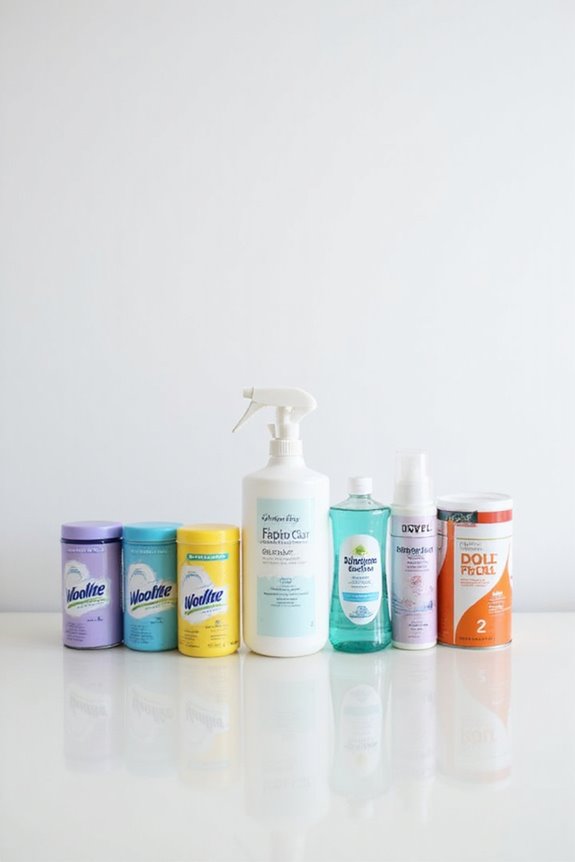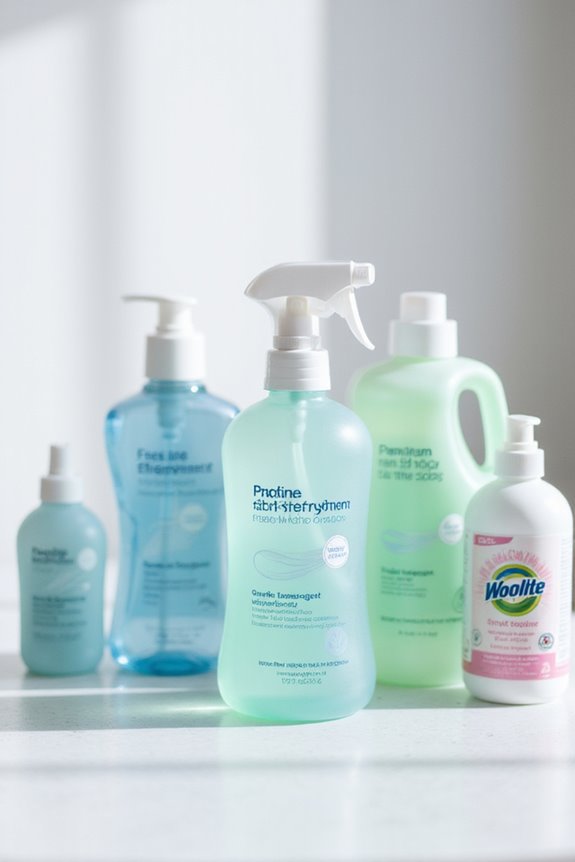To prevent that pesky mildew smell on our clothes, let’s remember a few key steps. First, we should always sort our laundry—keep damp clothes separate from dry ones. Next, a vinegar spray or soak can work wonders against mildew. When washing, hot water helps kill bacteria, but be sure to check fabric labels. Finally, let’s dry our clothes well with plenty of airflow. If we stick around, we’ll uncover more tips to keep our laundry fresh and clean.
Key Takeaways
- Always separate damp clothes from dry ones immediately to inhibit mildew growth.
- Shake out clothes outdoors before washing to remove mold spores.
- Use hot water (60°C/140°F) for washing to eliminate mildew-causing bacteria.
- Opt for quality drying racks and ensure proper air circulation for effective drying.
- Store fabrics in a cool, dry place to prevent moisture accumulation and odors.
Understanding Mildew and Its Causes
Mildew is like that uninvited guest who shows up when things get a bit too cozy and damp. It’s a type of fungus that thrives in warm, dark places, often appearing on our clothes as powdery or fluffy patches. We’ve probably all noticed those white, gray, or even pinkish spots on our favorite cotton or silk shirts. Mildew growth happens when moisture lingers, especially if we leave wet clothes in heaps or stash them in poorly ventilated closets. Plus, fungal spores love to feast on dirt and oils left on fabric. If we don’t tackle this issue, our clothes can suffer serious damage, leading to tears and nasty odors. So, let’s keep our fabrics dry and well-ventilated! Using detergents with effective odor-fighting ingredients can help maintain freshness and prevent mildew growth on clothes.
Proper Laundry Sorting and Handling
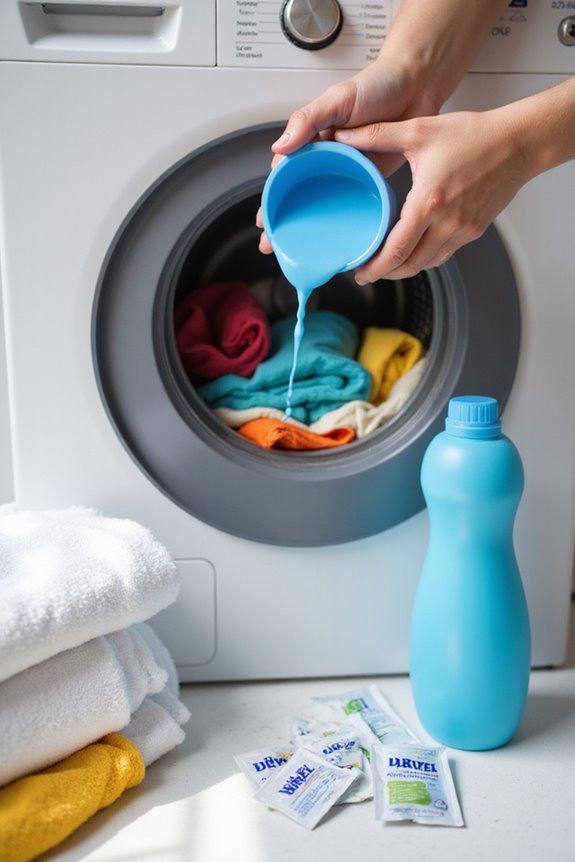
When we tackle laundry, proper sorting and handling can make a world of difference in keeping our clothes fresh and mildew-free. First, let’s separate damp clothes from dry ones right away. Leaving wet laundry in piles encourages mildew growth. We should also group fabrics by type—heavy items like towels shouldn’t mix with delicate ones. This helps with moisture control and keeps our clothes safe.
Don’t forget about color sorting, either! Isolating mildew-affected items prevents spores from spreading. Let’s shake out clothes outdoors before washing to dislodge any stubborn mold. By practicing good laundry organization, we can make drying more effective and maintain that fresh scent in our wardrobes. Additionally, using a detergent formulated for hard water conditions can help prevent mineral buildup that contributes to odors. A little effort goes a long way in keeping mildew at bay!
Effective Pre-Treatment Solutions
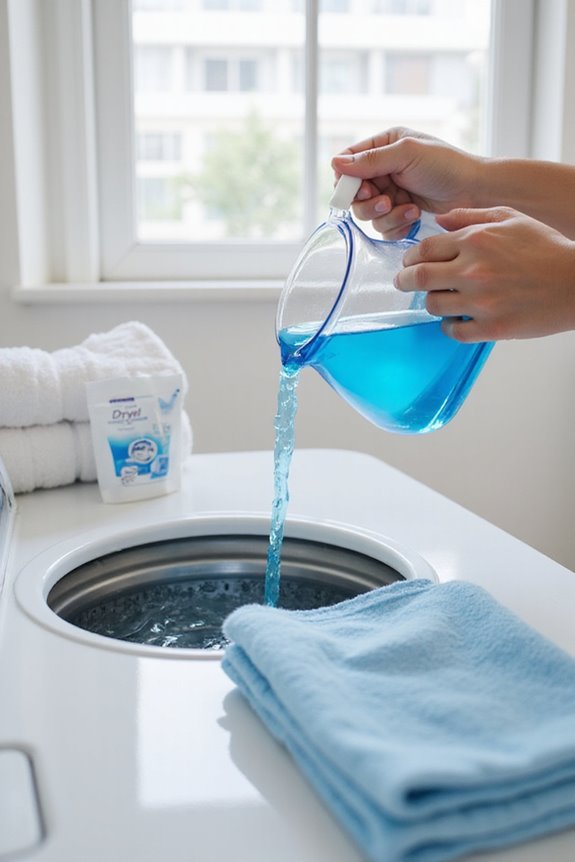
To keep our clothes smelling fresh and free of that musty odor, we’ve got some effective pre-treatment solutions at our fingertips. First up is the vinegar benefits—mix one part white vinegar with two parts water in a spray bottle. Spray it on affected areas and let it sit for 15 minutes. For a more thorough approach, soak clothes in a vinegar solution for 30 minutes.
Next, we can’t forget baking soda! Adding ½ cup during the wash absorbs odors well. For tough smells, mix baking soda with vinegar. It’s a powerful combo! Finally, consider a borax soak or oxygen bleach for stubborn mildew. We’ve found these methods help keep our laundry fresh and lively—no more musty surprises! Additionally, using detergents designed for odor removal can further enhance the freshness of your laundry, ensuring that lingering smells are effectively tackled.
Optimal Washing Techniques
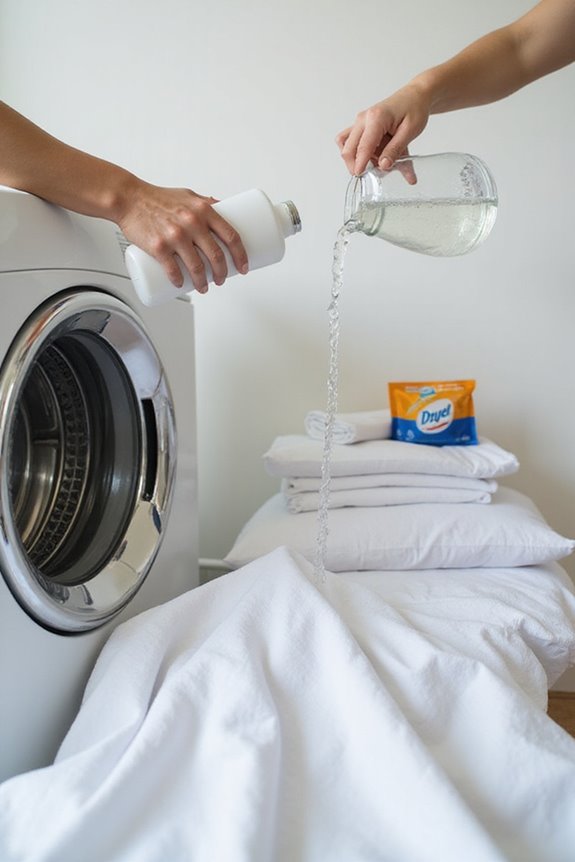
Getting our laundry just right can make all the difference when it comes to freshness. First, let’s talk about washing temperatures. Using hot water (60°C/140°F or higher) is key for killing mildew-causing bacteria, but we must check garment labels to avoid damage. For delicate fabrics, warm or cold water works better.
Next, our detergent choices matter too. Regular detergent might not cut it, so we should pick ones with oxygen bleach for serious odor removal. Adding half a cup of baking soda can help, too. Plus, let’s skip fabric softeners since they can trap odors. If we find persistent smells, a vinegar soak can work wonders. Just remember to rinse well afterward! Eco-friendly options can also provide effective cleaning without harsh chemicals. Happy washing!
Best Drying Practices for Prevention

We’ve all been there—pulling out a load of laundry only to be hit with that musty mildew smell. To keep our clothes fresh, we need to focus on effective drying techniques. First, let’s use quality drying racks that allow airflow management. Position them in well-ventilated areas, avoiding cramped spots. Remember to spread clothes out to maximize air exposure.
Also, we shouldn’t overload racks; it’s essential for quick drying. If the humidity’s high, we might want to run a dehumidifier or open windows to let some fresh air in. Finally, moving laundry promptly from the washer to the drying area helps prevent odors. Let’s keep our closets smelling clean by mastering these drying practices!
Fabric and Storage Considerations
When it comes to preventing that pesky mildew smell on our clothes, fabric choice and storage conditions play a major role. We should remember that natural fibers like cotton and linen are more prone to mildew due to their fabric composition. On the other hand, synthetic fabrics like polyester and nylon offer great mildew resistance.
When storing clothes, let’s choose breathable bags instead of plastic ones that trap moisture. We recommend keeping our garments in a dry, well-ventilated area to fight mildew. Also, ensuring everything is completely dry before storage is essential. We can even use silica gel packets or activated charcoal to absorb excess moisture. With these tips, we can keep our clothes smelling fresh and mildew-free!
Additional Remedies and Tips
To keep our clothes smelling fresh and free from that unwanted mildew odor, we can explore some additional remedies and tips that are both easy and effective. First, using white vinegar is a natural remedy; soaking our clothes in a mix of one part vinegar to two parts water for 30 minutes helps neutralize odors. We should rinse thoroughly afterward to avoid any lingering smell. Baking soda is another great option; adding it to our wash cycle absorbs odors safely. For stubborn mildew stains, lemon juice mixed with salt creates a handy paste. Finally, let’s remember to dry our clothes immediately after washing. With these simple practices, we can guarantee odor prevention and keep our laundry smelling delightful! Additionally, using baking soda products can enhance the cleaning process by effectively tackling organic stains and odors.
Frequently Asked Questions
Can I Use Essential Oils to Prevent Mildew Smells?
Absolutely, we can harness the magic of essential oil blends to combat mildew smells! These natural alternatives not only refresh our fabrics but also banish musty odors, creating a delightful aroma that invigorates our wardrobe!
How Often Should I Wash Gym Clothes to Avoid Mildew?
We should wash our gym clothes after every use, following frequency guidelines. Using gentle washing techniques and cold water helps maintain their quality and keeps bacteria at bay, ensuring fresh, odor-free activewear for our workouts.
Does Freezing Clothes Kill Mildew Bacteria?
Freezing clothes might pause mildew growth, but it doesn’t kill bacteria. For effective mildew prevention, we should focus on drying clothes thoroughly and storing them properly, ensuring they stay fresh and odor-free.
Are There Specific Detergents That Help Prevent Mildew?
When it comes to preventing mildew, we should consider using mildew resistant detergents and laundry additives. These products effectively fight mold growth, ensuring our clothes stay fresh and clean without unpleasant odors lingering behind.
Can I Use Fabric Softener With Mildew Prevention?
Did you know that over 65% of people use fabric softeners? While they add softness, their effectiveness in mildew prevention is limited. We should explore other techniques, like proper drying, to truly combat mildew.



